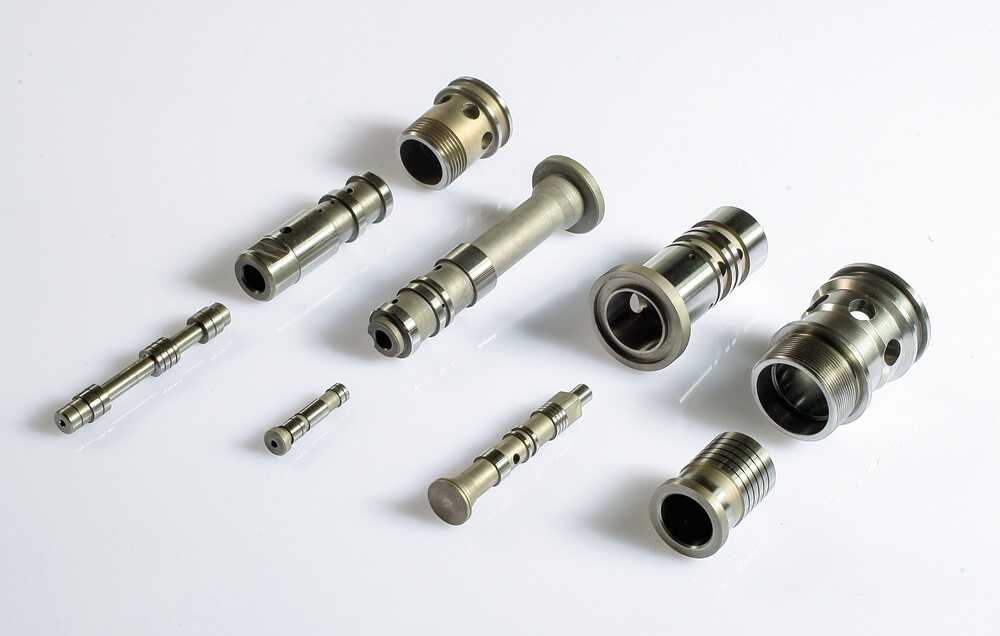Precision Machining of CNC Machining Aluminum Parts
1.Importance of Aluminum in CNC Machining
CNC machining is an advanced manufacturing process driven by computer control systems that has revolutionized the production of precision parts across a wide range of industries. While a wide range of materials can be used for CNC machining, aluminum stands out for its excellent properties and has become the first choice for a wide range of applications.
1) Machinability Advantages
Aluminum is known for its excellent machinability. Machinability refers to the ability of a material to be easily formed, cut, and shaped with minimal wear on cutting tools. Aluminum’s low density and relatively soft composition make it well suited to CNC machining processes. This can reduce machining time, increase productivity, and extend tool life, resulting in cost benefits for manufacturers.
2) Weight-to-Strength Ratio
One of the main advantages of aluminum is its excellent weight-to-strength ratio. Despite its light weight, aluminum has excellent strength and structural integrity. This feature is particularly important in industries such as aerospace and automotive, where reducing weight without compromising strength is a top priority. CNC machining of aluminum enables manufacturers to create complex and strong components for weight-critical applications.
3) Thermal Conductivity and Heat Dissipation
Aluminum has high thermal conductivity, which means it conducts and dissipates heat efficiently. This property is invaluable in the world of CNC machining. The ability to manage the heat generated during machining is essential to maintaining precision and preventing thermal damage to the material and cutting tools. Aluminum’s excellent heat dissipation helps extend tool life and improve machining accuracy.
4) Corrosion Resistance
Corrosion resistance is another outstanding feature of aluminum. This inherent property makes aluminum particularly suitable for use in harsh environments where exposure to moisture, chemicals, or other corrosive elements is a concern. Machined aluminum parts are corrosion-resistant, durable, and have a long service life, making them a reliable choice for a wide range of industries.
5) Cost-effectiveness and Economic Benefits
In addition to its mechanical properties, aluminum’s economic advantages have greatly increased its importance in CNC machining. Aluminum is abundant and is a cost-effective material. Its lightweight properties also reduce transportation costs, and the material’s recyclability is in line with sustainable and environmentally friendly manufacturing practices, further enhancing its economic appeal.
6) Design Flexibility and Complex Geometries
CNC machining can create complex geometries with precision, and aluminum complements this capability well. The ductility of the material and the precision of CNC make it possible to manufacture complex designs with high precision. This is particularly advantageous in industries such as electronics, which often require customized and precision-machined components.
In summary, the importance of aluminum in CNC machining is multifaceted, including its machinability, weight-to-strength ratio, thermal conductivity, corrosion resistance, alloy versatility, cost-effectiveness, environmental considerations, and design flexibility.
As technology and manufacturing processes continue to advance, the role of aluminum in CNC machining is likely to expand, providing manufacturers with a reliable and versatile material for producing high-quality precision parts in a variety of applications.
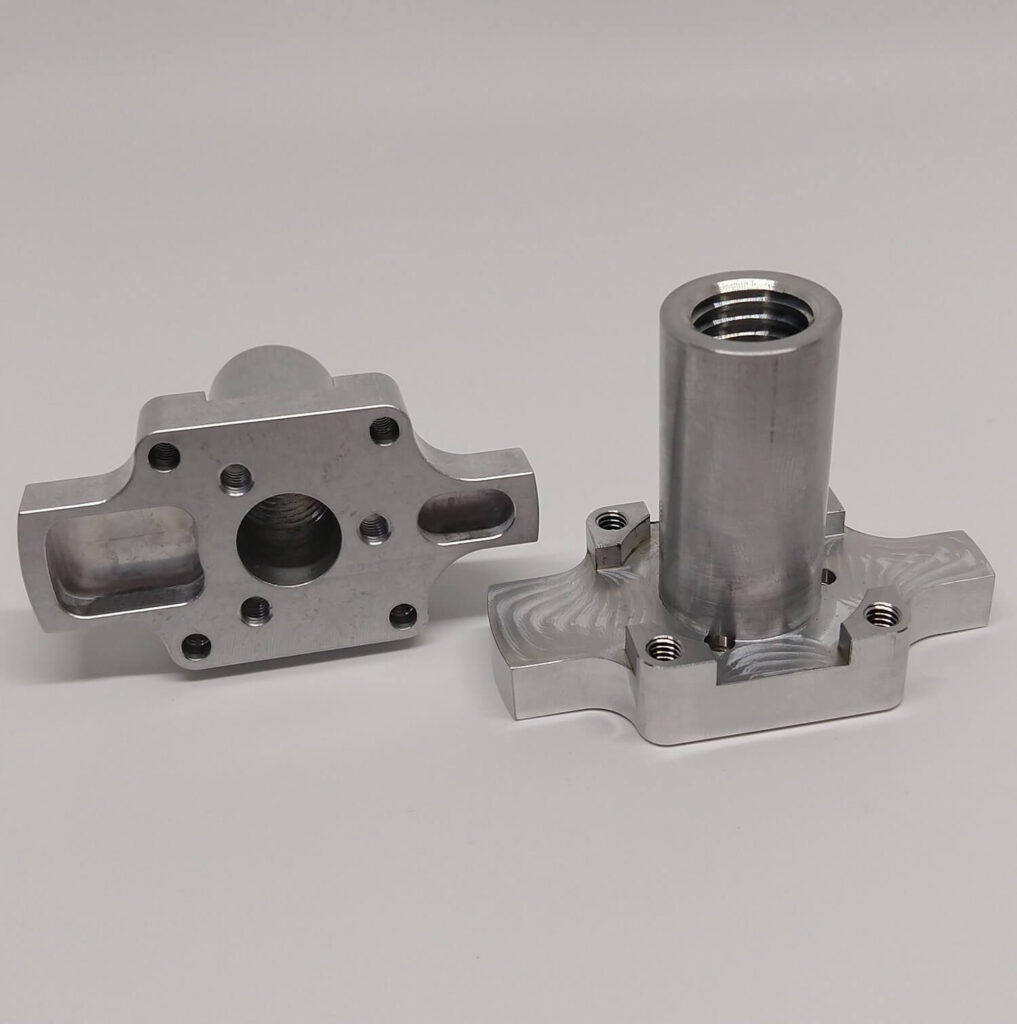
2.Performance of aluminum in CNC machining
1) Physical properties
Aluminum is a versatile and widely used material for CNC machining, with a unique set of physical and mechanical properties that make it suitable for precision manufacturing. Understanding these properties is critical to optimizing CNC machining processes and ensuring the production of high-quality aluminum parts.
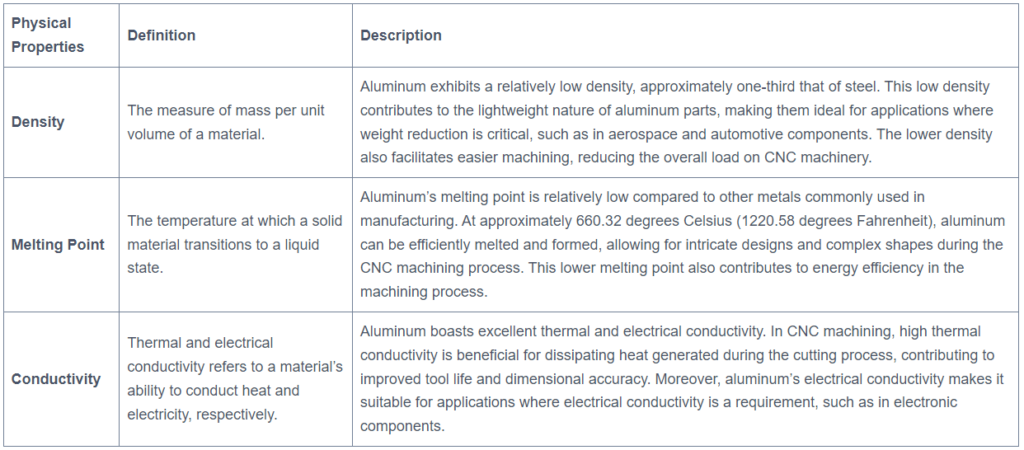
2) Mechanical Properties
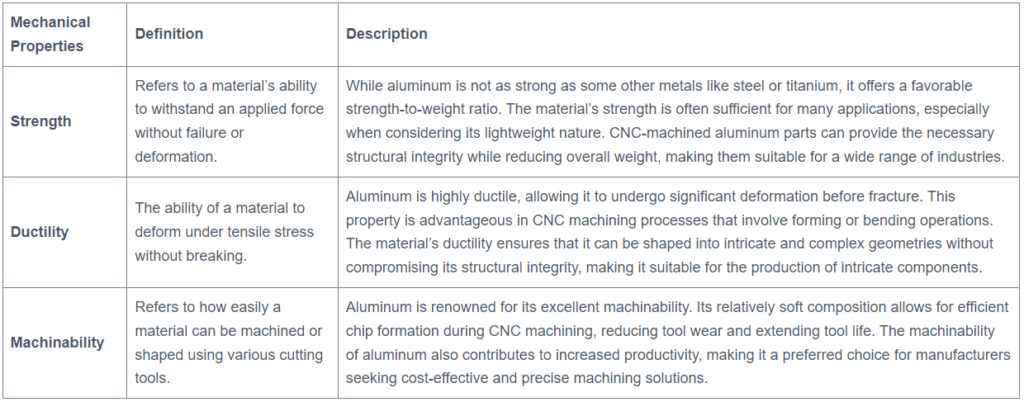
In summary, the physical and mechanical properties of aluminum, including low density, moderate melting point, high electrical conductivity, good strength-to-weight ratio, ductility, and excellent machinability, make it an ideal material for CNC machining. These properties enable a variety of industries to produce lightweight, complex, and structurally sound components.
3.Selection criteria for aluminum alloys

4.Types of aluminum alloys for CNC machining
- Application properties: Different applications may require specific properties. For example, aerospace applications may prioritize high strength, while architectural components may prioritize corrosion resistance.
- Mechanical properties: Considerations include the strength, hardness, and toughness required for the intended use. The choice of heat-treatable and non-heat-treatable alloys depends on the required mechanical properties.
- Corrosion resistance: High humidity environments or exposure to corrosive substances require alloys with excellent corrosion resistance. The 5XXX series has corrosion resistance and is often selected for such applications.
- Machinability: The machinability of an alloy is a key factor in CNC machining. Alloys with good machinability facilitate efficient chip formation and reduce tool wear. The 6XXX series, known for its excellent machinability, is often preferred.
- Weldability: For applications involving welding, the alloy’s ability to withstand and form strong welds is critical. Alloys such as the 5XXX and 6XXX series are known for their good weldability.
- Cost considerations: Economic factors, including raw material costs and processing techniques, play a role in alloy selection. Alloys that are more readily available, such as the 6XXX series alloys, may have cost advantages.
- Design requirements: Specific design considerations, such as the complexity of the part and the required surface finish, influence the choice of alloy. Certain alloys may be better suited to complex designs, while others may provide a smoother surface finish.
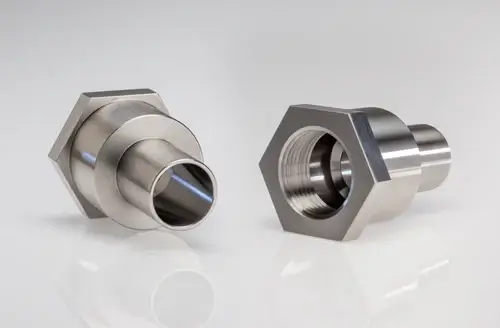
5.CNC machining of aluminum parts
CNC machining is a versatile manufacturing method that utilizes computer numerical control (CNC) technology to precisely shape and manufacture aluminum parts. Here is a detailed description of common CNC machining processes for aluminum:
1) CNC Milling
Process: CNC Milling uses a rotating cutting tool to remove material from a workpiece, forming a variety of features such as slots, grooves, profiles, and flat surfaces. It can be done on 3-axis or 5-axis machines, with the latter offering greater flexibility for complex shapes.
Applications:
- Create complex parts with multiple features for a variety of industries, including aerospace, automotive, medical, and electronics.
- Machining large flat components such as plates and frames.
- Producing prototypes and small batches of custom parts.
2) CNC Turning
Process: CNC Turning uses a single-point cutting tool to remove material from a rotating workpiece, typically cylindrical or bar stock. It forms features such as internal and external threads, diameters, grooves, and tapers.
Applications:
- Manufacture high-precision cylindrical parts such as shafts, gears, and bushings.
- Efficiently produce large quantities of identical parts.
- Create parts with internal threads and complex profiles.
3) CNC Drilling and Tapping
1.Drilling:
Process: CNC drilling uses a drill to create holes of various sizes for assembly, fasteners, or other functional applications.
Applications:
- Drill precise holes for bolts, rivets, and pins.
- Create channels for fluid flow or cooling purposes.
- Add access points for other machining processes.
2.Tapping:
Process: Tapping uses a threading tool to create internal threads in a drilled hole to facilitate screw connections.
Applications:
- Secure components with threaded fasteners for assembly.
- Create ports for pipes and fittings.
- Add connection points for electrical components.
In summary, CNC milling, CNC turning, and CNC drilling/tapping are integral processes in aluminum component machining. These processes use computer-controlled precision to accurately, efficiently, and flexibly shape aluminum components for a wide range of industrial applications.
6.Surface treatment of CNC machined aluminum parts
Surface treatment is a key aspect of CNC machining that enhances the aesthetic, functional and performance characteristics of aluminum parts. The following details the importance of surface treatment and common techniques for CNC machining aluminum parts.
1) Anodizing
Anodizing is an electrochemical process that enhances the corrosion resistance and durability of aluminum parts. The aluminum parts are immersed in an electrolyte and an electric current stimulates the surface to form an oxide layer. This oxide layer not only provides a protective coating, but can also be dyed to obtain a variety of colors. Anodizing is widely used in the aerospace, automotive and consumer electronics industries.
2) Polishing
Polishing is a mechanical process that involves removing surface blemishes and scratches to achieve a smooth and reflective surface. Various polishing techniques such as abrasive polishing, grinding and chemical polishing can be used depending on the desired gloss. Polishing is often used for high-end consumer products, decorative parts and parts that need to enhance visual appeal.
3) Coating
Coating involves applying a thin layer of material to the surface of the aluminum part. Common types of coatings include powder coating, paint and protective coating. Powder coating involves applying a dry powder that electrostatically adheres to the surface and then cures to create a durable surface. Paints offer a variety of options for achieving different colors and finishes. Protective coatings may include anti-corrosion coatings for enhanced durability.
In summary, surface treatment is a critical step in CNC machining aluminum parts, and its benefits include aesthetics, functionality, and durability. Anodizing, polishing, and coating are versatile technologies that meet different needs, allowing manufacturers to meet a variety of application needs in various industries.
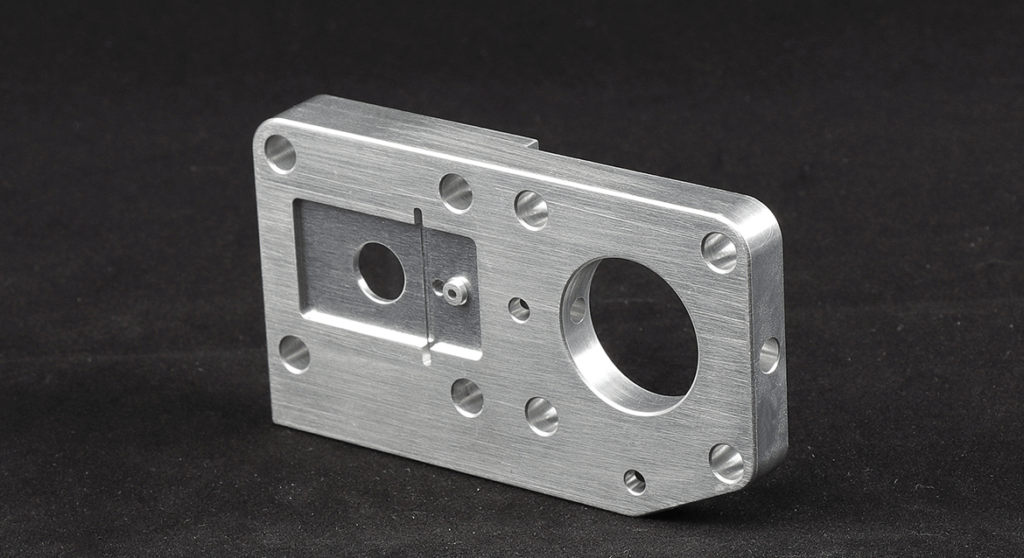
7.Best Practices and Tips for CNC Machining Aluminum Parts
CNC machining aluminum parts requires careful consideration of various factors to ensure the best results. The following is a detailed description of best practices and tips for key aspects of the CNC machining process.
1) Cutting Speed and Feed
- Cutting Speed: Aluminum has a relatively low melting point, and maintaining an appropriate cutting speed is critical to prevent excessive heat buildup. For aluminum, higher cutting speeds are generally preferred to avoid chip welding and achieve a better surface finish.
- Feed: The appropriate feed rate facilitates efficient chip evacuation and helps prevent tool wear. High feed rates are beneficial for aluminum machining, but should be balanced with cutting speeds to avoid overloading the tool.
2) Cooling and Lubrication
- Coolant Selection: Coolant helps dissipate the heat generated during machining, preventing the tool and workpiece from overheating. For aluminum, which has good thermal conductivity, water-soluble coolants are generally used. Select a coolant that will cool effectively and will not cause corrosion on the aluminum surface. Adjust the coolant flow rate based on the machining operation and tool engagement.
- Lubrication: Lubrication helps reduce friction between the cutting tool and the workpiece, promoting smoother machining and extending tool life. Consider using a lubricant or cutting fluid designed specifically for aluminum machining. Make sure it is properly applied to the cutting tool and workpiece interface to improve lubrication.
3) Fixtures and Workholding
- Sturdy Fixtures: Securely holding aluminum parts during machining is essential to prevent vibration and ensure accurate cuts. Use well-designed fixtures and clamps that provide adequate clamping force without causing deformation. Ensure the workpiece is securely and evenly supported.
- Minimize Material Vibration: Vibration can negatively affect surface finish and dimensional accuracy. Optimize cutting parameters to reduce chatter and vibration. Consider using vibration reduction tools and strategies to minimize harmonics in your machining process.
Implementing these best practices and tips can increase efficiency, accuracy, and overall success in CNC machining aluminum parts. Continuous monitoring, optimization, and attention to detail can help produce high-quality aluminum parts.
